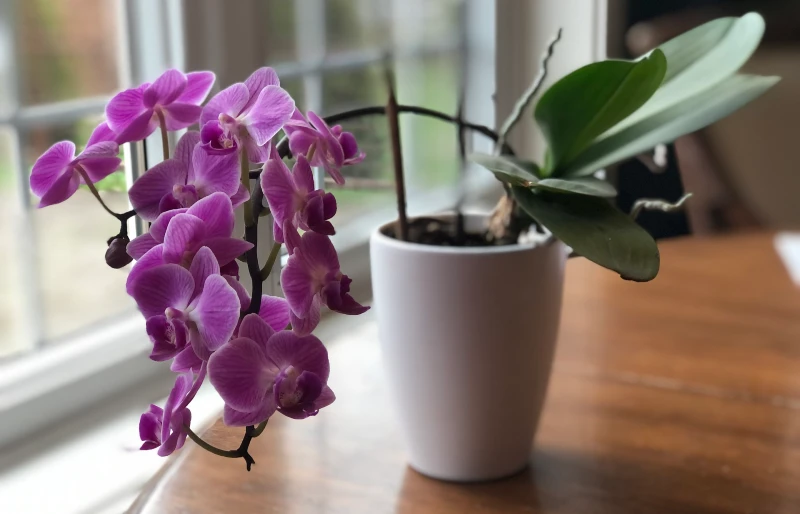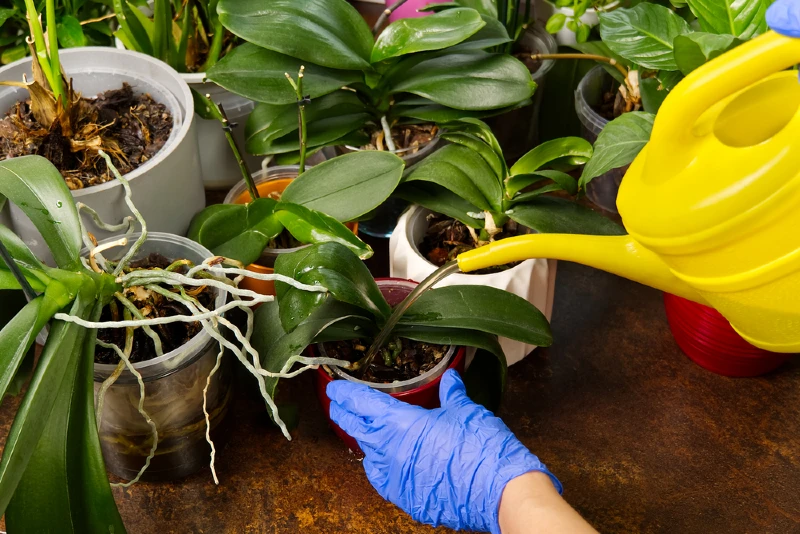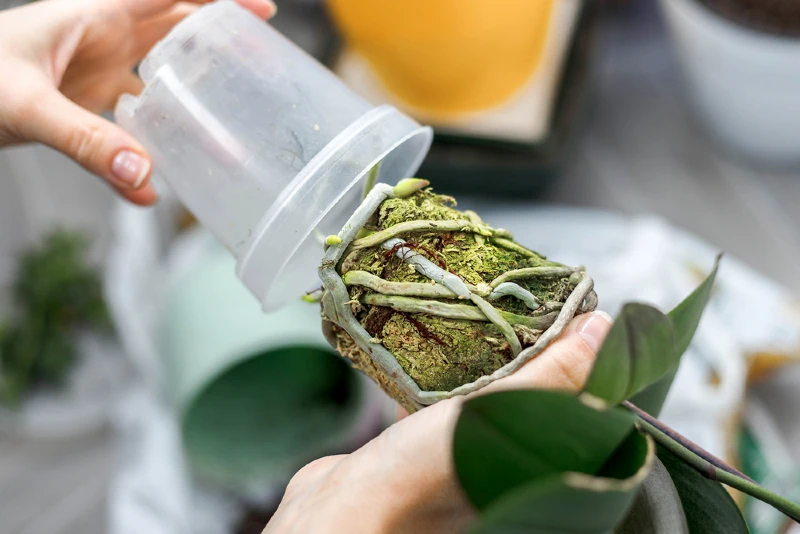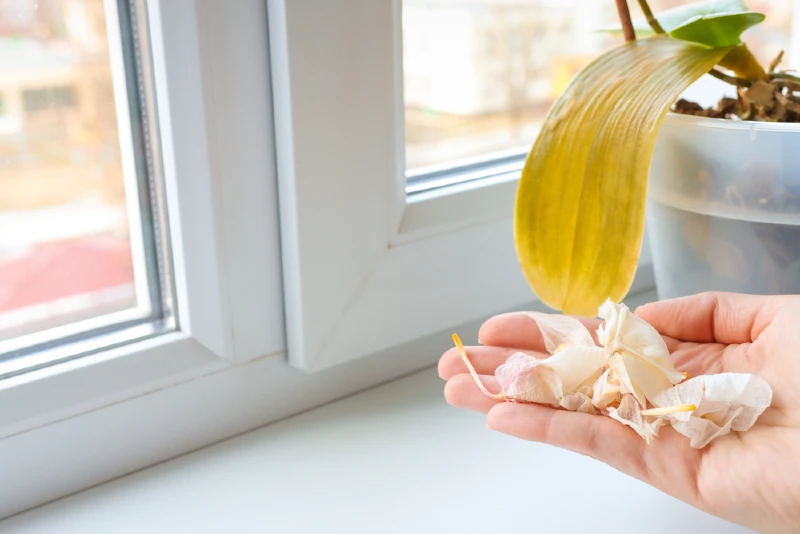How to Repot an Orchid with Air Roots (6 Expert Tips)
-
Pete Ortiz
- Last updated:

Repotting an orchid with air roots can be a challenging process, but it’s also an essential part of caring for your orchid. By following a few simple steps, you can ensure that your orchid will have the best chance to thrive. This step-by-step guide will provide you with everything you need to know to repot your orchid with air roots. Let’s discuss.
The 6 Tips to Repotting an Orchid with Air Roots
1. Selecting and Preparing a Potting Mix

Most orchids prefer a mix that is a combination of peat, perlite, and bark. When repotting an orchid with air roots, always select a potting mix that’s loose and has good drainage. Orchids thrive in a very moist environment. If the potting mix is too dry, the plant will end up with wilted and brown leaves. To ensure that your orchid has enough water, water the potting mix ahead of time. By thoroughly soaking the potting mix, the orchid will be left with just the right amount of moisture.
You can also prepare the potting mix by mixing in a bit of compost. Compost will help to enrich the potting mix, providing the orchid with nutrients that it needs to thrive. Add compost to the potting mix by simply breaking it up with your hands. If you’re repotting an orchid with air roots that requires a bit more water, you can also add a bit of perlite (a soil amendment) to the potting mix.
2. Drainage and Selecting the Right Pot
When selecting a pot for your orchid, you’ll want to make sure that it’s the right size and has enough drainage holes. You’ll also want to make sure that the pot has a good drainage system, such as a tray or saucer that sits underneath the pot. Avoid pots that have a closed bottom as they don’t allow the water to flow out of the pot. If you don’t provide proper drainage, the orchid’s roots could rot from sitting in water for too long (what’s known as “root rot“).
3. Adding the Potting Mix

Once you’ve selected the right potting mix and have properly prepared it, add it to the pot. Start by placing several pieces of newspaper or paper towels in the bottom of the pot to protect the potting mix from the edges of the pot. Next, add the potting mix and make sure that it’s level with the top of the pot.
Now, carefully remove your orchid from its current pot and place it in the new pot. Gently pack the potting mix around the roots of the orchid, including as many air roots as possible, completely covering them. This will ensure that there are no air pockets in the potting mix and that the roots are completely covered and protected.
Once you’ve filled the potting mix around the roots of the orchid, give the pot a good shake to make sure that everything is evenly distributed and that there are no large gaps in the soil.
Now, water the potting mix and make sure that it is thoroughly moistened. You can place the orchid in a shaded area while it is recovering from the repotting process.
4. Sunlight Precautions
When repotting an orchid with air roots, be sure to give your orchid the proper amount of light. Indirect sunlight is best for orchids, as it’ll provide just enough light without burning the plants’ delicate leaves – something that’s a common issue with gardeners growing orchids for the first time. Once you’ve repotted your orchid, place it in a shaded area that receives indirect sunlight at least 8-12 hours a day. Now, make sure that the orchid is not sitting in direct sunlight as this can damage the leaves.
5. Watering Sessions

After repotting your orchid, you should allow the potting mix to thoroughly dry before watering the orchid. This will prevent you from potentially overwatering it. You can check to see if the potting mix is dry by squeezing a handful of it. If the potting mix feels crumbly or too dry, then you should definitely water it. But if it’s still moist or damp, wait a day or two and check again.
When watering an orchid, you should water the potting mix, not the orchid itself. Remember, the leaves, flowers, and stems will get all of the water and nutrients that they need from the roots, so there’s no need to mist or water them directly.
Now, make sure that you water the potting mix thoroughly, but do not over-water it. The potting mix is moist at all times, but not soggy. So, for example, if you see water sitting on top of the soil for several minutes after you water it, you may want to pour some off of it to ensure good drainage.
6. Adding Fertilizer
Orchards are fertilizer-hungry plants that need to be fertilized on a regular basis. It’s best to use a balanced fertilizer such as 20-20-20 (or a diluted 30-10-10 in some cases) so that they get all the trace elements that they need. Also, make sure that the fertilizer contains no or very little urea, as this can harm your plant.
And there are several options to consider when it comes to fertilizing your plant. For example, you can use spikes, liquid, or ground fertilizer options. In any case, you’ll need to mix the fertilizer with the soil and apply it directly on top. Generally, orchids require fertilizer treatment about every 2 weeks during the spring and summer months and once a month (or every 2 months) during the winter dormancy period.
FAQs About Orchids
What Are the Different Types of Orchids?
To date, there are about 30,000 species of orchids that grow all over the world, but only a small percentage of those species are commonly grown as houseplants. Most orchid plants fall into one of three types: tropical, subtropical, or semi-tropical. Tropical orchids prefer high humidity and plenty of sunlight. Subtropical orchids prefer less humidity and less sunlight. Semitropical orchids prefer a mix of both.

Do Cold and Hot Temperatures Affect Orchids?
Absolutely, the temperature is actually one of the most important factors when growing orchids. Tropical orchids prefer warm temperatures, while subtropical and semitropical orchids prefer cooler temperatures. Orchids can’t survive extreme temperatures; they need a temperature-controlled environment when grown at home or in a garden. So, if you place tropical orchids near a south-facing window, make sure the plants don’t get too much direct sun (the leaves will burn) and they may overheat. But if you live in a warm climate, you can also grow tropical orchids inside when the weather gets chilly.
What Kind of Soil Is Best for Orchids?
Orchids prefer sandy, loamy soil that drains fairly easily. There is no shortage of orchid-specified potting soil available on the market. Of course, you can use a commercial orchid potting mix, or you can make your own orchid potting mix by combining equal parts peat moss, perlite, and organic fertilizer. Avoid growing orchids in soil that’s too dense or compacted, as this can cause your plants to develop root rot – a disease that can be hard to treat.
How Can You Tell If Your Orchid Needs Repotting?
Typically, orchids need to be repotted about every 2 to 3 years to maintain optimal health. You know it’s time to repot your orchid if the roots are growing out of the bottom of the pot or if the orchid is noticeably wilting – this means that the roots are struggling to breathe.

How Can You Tell If an Orchid Plant Is Sick?
When it comes to some plants, it can be difficult to determine whether they’re sick. But this is especially true for orchid plants, which are known for being delicate and sensitive. Here are some common signs:
Wilting
One of the most common signs that an orchid plant is not well is wilting. It occurs when the plant’s leaves and stems start to droop and become soft. Wilting can be caused by a variety of issues, such as an insufficient amount of water, too much sun or fertilizer, or a lack of nutrients. If an orchid plant is wilting, it’s important to analyze the environment and determine what might be causing the issue.
Discoloration
Another sign of an unhealthy orchid plant is discoloration. If the leaves start to turn yellow, brown, or black, it could be a sign of disease (or a pest infestation). Fungal growths, such as powdery mildew, can appear on the leaves of the plant. And if the stem or roots of the orchid plant appear to be discolored (such as brown or black), it may indicate root rot. Root rot is a fungal infection that can be fatal to orchid plants, so it’s important to act quickly if you notice this.
Spotting
If an orchid plant is suffering from a pest infestation, there will likely be visible signs. Additionally, there may be signs of pests, such as aphids or scale insects, on the stem or leaves. Oftentimes, you will notice spots on the top or undersides of the leaves that may be white, black, or dark gray. It’s important to deal with pest infestations as soon as possible because many of these pests can reproduce several times in a matter of days, causing your plant’s condition to worsen. You can use neem oil, rubbing alcohol, and pesticides to get rid of them.

Do Orchids Need to Be Protected Against Drafts?
Yes and no. Yes, orchids do need moving air, as they thrive in a constant, humid breeze. But they should not be near hot air vents or air-conditioning. Strong cold or hot drafts can stress out the delicate orchid plant causing the leaves to turn brown or even fall off in some cases. So, to say, be sure to place your plan at least 6 to 8 ft. away from your air conditioner, vents, or exterior doors.
How Often Does an Orchid Bloom?
It really depends on the orchid. But many of these plants bloom only once a season, while others bloom multiple times throughout the year. And then you have other orchid varieties, such as moth orchids, which are constantly blooming.
How Long Can Orchids Live?
The answer to this question depends on the orchid variety and how well it is being maintained. Believe it or not, wild orchids can live up to 20 years. Most potted or planted orchids won’t have this type of lifespan. But on average they’ll live anywhere from 7 to 15 years with good maintenance.

How Long Can Orchid Flowers Last?
It depends on the orchid type and how it was treated. For example, the blooms of hybrids from the genus Cattleya can last anywhere from 1 to 4 weeks, while the Phalaenopsis hybrids can last up to 4 months.
Which Orchid Varieties Are Easiest to Grow?
It all depends on whether you’re looking for something that can be grown indoors or outside.
Phalaenopsis is one of the most rewarding and easy-to-grow orchids and it’s one of the most popular orchids grown in American homes. They adapt well to their environment. The flowers will stay in bloom for 2 to 3 more months after the first flower buds open.
The Odontoglossum and Oncidium hybrids are also very popular among orchid growers due to their environmental flexibility and beautiful cascades of long-lasting flowers. You can easily grow the plants in your home or outside on a covered patio. That being stated, you will need to keep an eye on the temperature if grown outdoors.

Do Orchid Flowers Have a Fragrance?
Yes, for many varieties these plants are fragrant, which is why they are known to draw wildlife and insects to their flowers during the blooming season. Some orchids are strong enough to fragrance a whole greenhouse or living space. And interestingly, others mimic familiar scents like raspberry, coconut, and lilacs. But some plants (like the Psychopsis) have no scent and rely on color and shape to attract pollinators or insects.
Conclusion
Orchids are beautiful and delicate flowers that can easily liven up any room or outdoor garden. That being stated, it’s best to be mindful of how you repot them, especially if they have air roots, to ensure that they continue to thrive and grow abundantly. Hopefully, the tips in this guide were helpful.
- https://orchidresourcecenter.com/how-to-repot-an-orchid-with-air-roots/
- https://www.youtube.com/watch?v=7GGWbBt2SvA&ab_channel=MissOrchidGirl
- https://www.youtube.com/watch?v=W5dh9q2cRcI&ab_channel=Sam%27sOrchids
- https://www.wikihow.life/Repot-Orchids-with-Air-Roots
- https://www.aos.org/orchids.aspx
- http://www.aboutorchids.com/
- https://www.gardenista.com/posts/10-things-nobody-tells-orchids/
- https://www.thespruce.com/orchid-identification-1315976
Featured Image Credit: tallislandgirl, Pixabay
Contents


